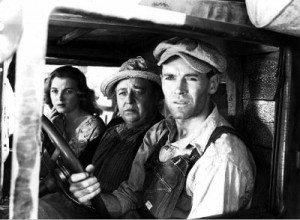The timeless classic The Grapes of Wrath by John Steinbeck tells the story of the Joad family during the Dust Bowl era of the 1930s and how they leave their home in Oklahoma to try to find work in California. However, the novel is more than just about the Joads’ expedition across the western United States. Symbols play a key part in the meaning of Steinbeck’s The Grapes of Wrath.
One of the main symbols comes very early in the story, the turtle. As the turtle is walking across an old dirt road, a car begins to come near where the turtle is crossing. The car swerves in order to miss the slow, helpless turtle. The turtle ducks into its shell for safety.
When it realizes that it is safe, it peaks its head out of its protective shell and continues its trek across the road. A few minutes later a truck comes down the road the other way.
The driver swerves intentionally to hit the defenseless animal. The trucker hits the side of the turtle’s shell, quickly flipping it over. The turtle struggles to get itself back on its underside, thrashing its arms and legs with all of its might.
Finally, it is able to turn itself over. After this near catastrophe, the turtle sits in the safety of its shell again, not knowing if it was going to make it across to the other side of the road. It begins walking again. Using the symbol of the turtle, Steinbeck seems to be suggesting that outside factors affect the fate of the turtle more than the turtle himself. This is closely related to human fate. We, too, are at the mercy of outside factors such as our surroundings.
Most of the other symbolism in the novel is biblical, the main source being the book of Exodus in the Old Testament. In The Grapes of Wrath, the Joad family leaves Oklahoma because they get into a lot of debt that they can’t pay; so they have been “tractored out” of their homes. They then begin a long journey to California because it is said that California is a great place to find work.
Along the way, they encounter many problems such as their car breaking down and the grandparents dying. This is reminiscent of the book of Exodus when the children of Israel leave Egypt when they have been slaves, to get to the Promised Land. On their journey, there are numerous problems and obstacles that they have to get through to achieve their goal.
One of the most important symbols in the novel comes from the New Testament. It involves Jim Casey, the former preacher, symbolically representing Jesus Christ in that he gives his life for the cause of helping others. One of the main indications of this is right before Jim Casey is killed, he yells “You fellas don’ know what you’re doin.”
Right before Jesus Christ is nailed to the cross, he says “Forgive them, Father, for they know not what they do.” Toward the end of the novel, Tom talks about how he wanted to follow Jim’s ways and carry out the things that Jim wanted to be done.
Therefore, in a way, Tom Joad represents one of the Disciples. In another biblically symbolic passage, Tom wraps up Rose of Sharon’s stillborn baby and sends him down the current of the floodwater. This represents Moses’ sister Miriam wrapping him up and sending him down the Nile River.
Symbols are important in a story, and they play a key part in the meaning of Steinbeck’s The Grapes of Wrath. They help to develop the personality of the characters and add a moral meaning to the narrative. All of these symbols are related to the plot as well as to the meaning of the novel. The result is a deeply moving story of human beings engaged in a struggle for a better life.
Works Cited
Steinbeck, John. The Grapes of Wrath. New York: Penguin Group, 1976

